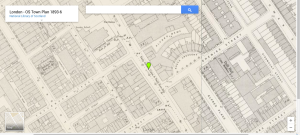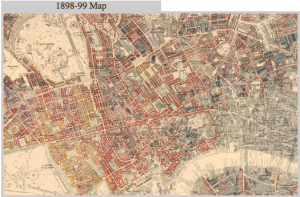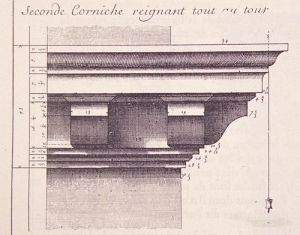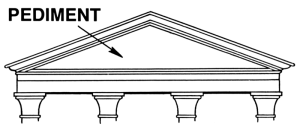
I chose to research Goodge Street from Sherlock Holmes and the Adventure of the Blue Carbuncle. Goodge Street appears in this story as the location in which the man’s hat was found: “found at the corner of Goodge Street, a goose and a black felt hat. Mr. Henry Baker can have the same by applying at 6:30 this evening at 221B, Baker Street” (Carbuncle).

According to the Charles Booth Online Archive Poverty Map, the general area of Goodge Street was middle class and ranged from “Mixed. Some comfortable others poor” and “Middle class. Well-to-do” people. The British History Online archive was able to give me more information about the actual architecture of the street. The houses were “kept to a fairly uniform height,” and below the third floor of every house there was a modillion cornice. A modillion cornice is a type of extravegant molding that can be used in architecture or even on certain types of furniture.


A pediment was above each window of the upper range windows. Today, parts of this design are still in place. Of course, over the decades, Goodge Street has faced architectural changes. The neighboring street, Charlotte Street, was rebuilt, which affected the design of Goodge Street as well as any damage that was accumulated by “the raids.” After doing a quick Google search I realized the raids the author was talking about were the air-raids in World War II. Today, Goodge Street houses the Goodge Street underground tube station, but during the second World War it was used as a bomb shelter for Allied forces.

Besides their height, the houses themselves had very little “uniformity in the size of the units, some having three and others two windows in their width according to requirements” (British History). When this sketch was drawn most of the buildings had shops on the first floor.
The information I have gathered about Goodge Street reflects on the Sherlock Holmes’ story because it is located near Baker Street, where Sherlock Holmes lives. Most of his detective work happens in his surrounding neighborhood, so it makes perfect sense that he would be walking through Goodge Street and then find a clue to a case. More specifically for the story, it makes sense that it took place on Goodge Street because of the financial state in that neighborhood. The citizens who lived there were a mix of middle class, “well to do” people. When Sherlock finds the hat he has trouble placing exactly where the owner would stand financially. It makes sense that the owner was once wealthy, and then down on his luck and living in a neighborhood of middle class.
Sources:
https://www.google.com/maps/d/u/0/viewer?mid=zs2aHyi7W8Ek.kggHTef2F49I&hl=en
http://www.british-history.ac.uk/report.aspx?compid=65160
‘Goodge Street’, Survey of London: volume 21: The parish of St Pancras part 3: Tottenham Court Road & neighbourhood (1949), pp. 34-35. URL: http://www.british-history.ac.uk/report.aspx?compid=65160 Date acc